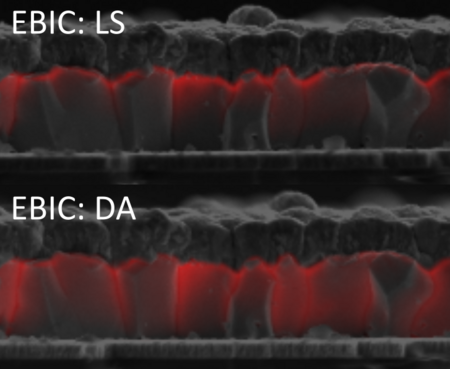Physics of Solar Cell Modules
Kontakt
Prof. Dr. Sascha Schäfer
Raum W01A 1-105
Telefon +49-441-798-3536
Dr. Stephan Heise
Raum W2 1-186
Telefon +49 441 798-3008
Physics of Solar Cell Modules
Our group deals with the physics of thin film solar cells and addresses material scientific problems of the involved functional materials. Our main topics relate to the application of chalcogenide semiconductors—such as Cu(In,Ga)(Se,S)2 (Chalcopyrites) and Cu2ZnSn(S,Se)4 (Kesterites)—in solar cells and commercial photovoltaic modules. Our scientific interest focuses on the fundamental physics of heterojunction solar cells and on the investigation of efficiency-limiting properties of the involved materials and interfaces. To address specific problems we employ a broad spectrum of diagnostic tools, ranging from structural and chemical analysis over optical, electronic, and optoelectronic characterization to numerical simulation of optics as well as devices [1–3]. On the production side, we grow Kesterite absorber material as well as all other functional layers needed for the complete solar cell device [4]. The absorber layers are mainly fabricated using a two-stage process of chalcogenising a vacuum- or solution-based metallic precursor [5].
Figure 1: The influence of different heat treatments on the current collection abilities in a CIGS thin film solar cell, thereby demonstrating the effect of metastable cell changes.
[1] J. Schoneberg, J. Ohland, P. Eraerds, T. Dalibor, J. Parisi, M. Richter, Accessing the band alignment in high efficiency Cu(In,Ga)(Se,S)2 (CIGSSe) solar cells with an InxSy:Na buffer based on temperature dependent measurements and simulations, Journal of Applied Physics 123, 155701 (2018).
[2] J.F. López Salas, M. Richter, J. Parisi, S.J. Heise, Simulation of photoluminescence lifetime and open-circuit voltage in Cu(In,Ga)Se2 thin film solar cells, Journal of Applied Physics 122, 203103 (2017).
[3] S. J. Heise, V. Gerliz, M.S. Hammer, J. Ohland, J. Keller, I. Hammer-Riedel, Light-induced changes in the minority carrier diffusion length of Cu(In,Ga)Se2 absorber material, Sol. Energy Mater. Sol. Cells 163, 270-276 (2017).
[4] T. Taskesen, V. Steininger, W. Chen, J. Ohland, U. Mikolajczak, D. Pareek, J. Parisi, L. Gütay, Resilient and reproducible processing for CZTSe solar cells in the range of 10%, Prog Photovolt Res Appl. 26, 1003–1006 (2018).
[5] M.H. Sayed, E.V.C. Robert, P.J. Dale, L. Gütay, Cu2SnS3 based thin film solar cells from chemical spray pyrolysis, Thin Solid Films 669, 436-439 (2019).



